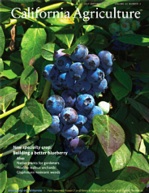All Issues

New specialty crop: Building a better blueberry
Cover:
New varieties that require fewer chilling hours have made it possible to grow blueberries in California. More than 4,500 acres of this valuable specialty crop are currently in production. Photo: Vanessa Bremer





